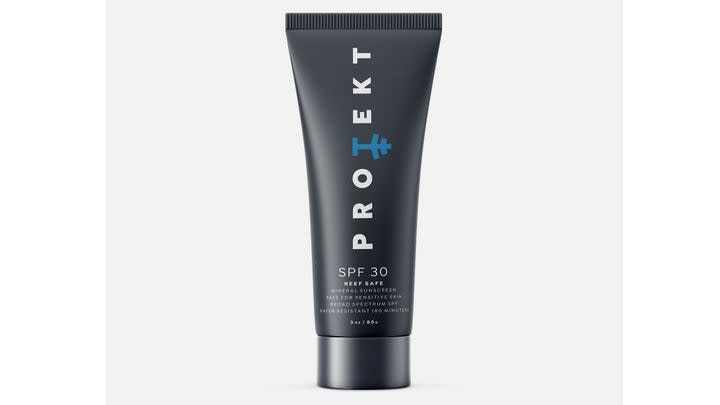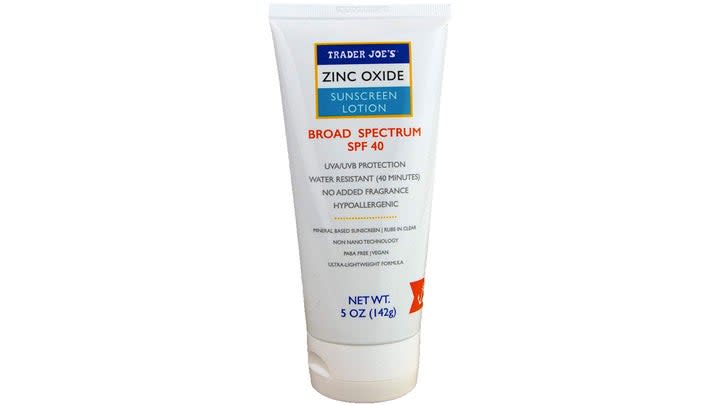Ask A Gear Guru: What’s The Best Sunscreen For Triathletes?
Triathlete
If you’re in North America, you’re feeling the effects of the hot summer sun on your skin pretty much every day. As the sun's angle in the sky becomes more direct, UV radiation also increases, according to the FDA, and combined with longer days, that increase in radiation can cause more damage to your skin. The good news is that more and more sunscreen brands are taking creative and natural approaches to skincare (and the environment), so now there are tons of options. Below we'll give you some sage advice on how to keep your skin happy and safe, what to look for in the best sunscreens for triathletes, and provide a list of some of our favorites for swim, bike, and run.
What Are You Doing?
Well, this could go in any direction, but in the scope of this article, be sure you're taking realistic stock of which workouts you'll be doing outside before you even think about buying sunscreen. If you're out in the pool, you'll need waterproof sunscreen. If you're going out for a multi-hour long ride, you'll probably need to reapply (so get a smaller tube to bring along). If you're running, you just want to be sure you have something super sweatproof that'll last as long as your long run does, unless you want to dry off and then reapply halfway through. As a solution, some triathletes will use a different brand/model for each sport because, yeah, triathletes need more stuff. But in all seriousness, even the most expensive sunscreens have their intended use, and as triathletes, we need to be sure we're using our sun protection properly.
SPF What?
This used to be a pretty cut-and-dry proposition, but new research is showing that the types of UV rays that a sunscreen protects you from is actually more important than a high SPF number. In fact, in our "line of work," SPF isn't as useful as you'd think because we're not (generally) just statically sunbathing--so no matter how high the SPF, we still need to reapply after X amount of minutes or else SPF 1,000,000 doesn't do us any good anyway. But just for reference, the SPF factor refers to how many hours you'd theoretically need to be in the sun with that sunscreen before the equivalent of one hour unprotected. In other words, if you wear SPF 30, and you generally burn unprotected after 20 minutes in the sun, you'd theoretically be fien for 10 hours of sunbathing. But if you're sweating or swimming, all of this goes right out the door. Also, bear in mind, this only refers to UVB rays, not UVA rays. While the jury's kind of out on the level of damage that UVA rays do to your skin, it's important to get a broad-spectrum sunscreen that protects from both.
What's Safe For You, What's Not?
Again, this has become a point of contention in recent years, but if you're erring on the side of safety (maybe at the expense of cost, need to reapply, and aesthetics), here's what the FDA says about sunscreen ingredients' safety, in terms of your body:
Two ingredients are "generally recognized as safe and effective" (GRASE):
Titanium dioxide
Zinc oxide
Two ingredients that are NOT GRASE (though these ingredients are not found in sunscreens the U.S., so don't be wowed by brands that use a lack of these two chemicals as a selling point):
PABA
Trolamine salicylate
The FDA is investigating these ingredients and their absorption effects into the human body before they can be classified as GRASE:
Ensulizole, octisalate, homosalate, octocrylene, octinoxate, oxybenzone, avobenzone (all commonly found in the U.S.)
Cinoxate, dioxybenzone, meradimate, padimate O, sulisobenzone (not found in the U.S.)
So if you're listening to the FDA--not a bad source of unbiased information--the idea is that those complicated-sounding chemicals in the two lists above are not necessarily bad, but that the FDA can't say for certain that they're safe either. In a recent study searching for answers, an FDA representative said, "Results from our study released today show there is evidence that some sunscreen active ingredients may be absorbed [from the above list]. However, the fact that an ingredient is absorbed through the skin and into the body does not mean that the ingredient is unsafe, nor does the FDA seeking further information indicate such. Rather, this finding calls for further industry testing to determine the safety and effect of systemic exposure of sunscreen ingredients, especially with chronic use."
Long story short: More unbiased testing needs to be done on the "iffy-GRASE" ingredients before they can make a ruling, but the FDA is far from sold on their safety for those who use sunscreen a lot (like us).
As a side note, it's important to note that those -ate, -ene, -one ingredients are all very popular in basic grocery store, convenience store, and drug store settings. They're also generally the sunscreens that are the cheapest AND rub in the best/easiest. My advice here is: We're triathletes, we're never going to look super cool while training, and coping with some white stuff on your neck (a common complaint against the -ide-based sunscreens) is probably not going to change your world in the same way that cancer will.
What's Safe For The Environment?
Another murky area! Literally. While the entire state of Hawaii will ban sunscreens with the chemicals oxybenzone and octinoxate in 2021--due to findings that those two chemicals are responsible for damaging coral, there's actually evidence that a few of the other -ene and -ate chemicals are bad for sea life as well. According to a (generally unbiased) Consumer Reports' story, chemicals like octocrylene, homosalate, and octisalate can affect various types of fish. In that same story, they note that there are no regulations around the term "reef-safe," so consumers need to be diligent in reading those alphabet soup-like ingredient labels on the back of sunscreens--no matter how "reef safe" they claim to be. Here, again it's important to know that there's still a lack of testing on what's for sure safe, but the -ide chemicals (titanium oxide and zinc oxide) still haven't been proven as harmful--unlike a few other chemicals listed.
That said, everyone agrees some sunscreen is better than none at all, so we've listed a few options across the spectrum, and you'll have to decide your own risk tolerance as an educated consumer.
The Best Sunscreens For Athletes: Protekt SPF 30
$6/ounce – $18, 3oz. tube

There's a lot to like about this veteran-owned brand that makes more than just sunscreen (they also make a few supplements). Protekt uses NSF-certified organic ingredients and 20% zinc oxide for broad spectrum protection (UVA and UVB), and due to those simple ingredients--which also include a host of skin-moisturizing minerals as inactive ingredients--this is also actually a reef-safe sunscreen. In application, Protekt isn't the most moisturizing/smooth, but it's also not as chalky or white as many other zinc-based sunscreens--in fact, it occupies a good middle ground between quality ingredients and ease-of wearing, though it's not cheap. Like others, it requires another coat after 80 minutes of water use, despite its 30 SPF rating.
The Best Sunscreens For Athletes: Neutrogena Sensitive Skin Face Liquid Sunscreen SPF 50
$10/ounce – $15, 1.4oz. tube

This is a great choice for faces, due to its super-light, easy-to-apply formula. It's easier to apply than a stick formula and absorbs to a shine-free finish, which can be rare for zinc-based sunscreen. We love this for every day or a heavy application for running, racing, and water sports. Composed of 4.9% titanium dioxide and 2.9% zinc oxide, Neutrogena’s tiny tube is a great mineral blocker to throw in a jersey pocket or run bag.
-Melanie Mitchell
The Best Sunscreens For Athletes: Endurance Shield SPF 45
$6/ounce – $24, 4oz. tube

While this sunscreen contains one of the -ates on the iffy list (octyl methoxycinnamate, aka octinoxate), this is still an excellent choice for something that combines the chemical blocker in octinoxate with the physical blocker in zinc. Not to mention that this is probably one of the best applying sunscreens on the list that actually feels and smells like a fancy moisturizer--not a sunscreen. The good news here is that Endurance Shield is made by triathletes, so it's super waterproof, SPF 45, UVA UVB, and assumes that the wearer will be using it a lot, so the ingredients are made to help mitigate the brutality we inflict upon our outer layer of dermis. They also make a small 2oz. version that's perfect for carrying on the bike when you need to reapply on long rides.
The Best Sunscreens For Athletes: Z Blok Clear Zinc Facial Stick
$26/ounce – $13, .5oz. stick

Though the name might not ring a bell to most triathletes, Z Blok makes a solid stick for a solid, non-greasy facial coverage for training and racing. The formula will not burn eyes and is sweat-resistant, critical for hot, summer running and riding. We loved the solid formula and relatively clear application for a zinc-based product with 4.7% zinc oxide and 6% titanium oxide.
-MM
The Best Sunscreens For Athletes: Trader Joe's Zinc Oxide SPF 40 Lotion
$2/ounce – $10, 5oz. tube

Though not everyone has access to a Trader Joe's nearby, if you do, and you're a triathlete, you should give this zinc-based sunscreen a try. It goes on smoother than most mineral options, though it does take some rubbing to "get the white out." It has none of the maybe-bad -ates, -ones, or -enes as the active ingredients--only 20.5% zinc--though it does have an assortment of other inactive ingredients, but nothing that raises any immediate red flags. It also has UVA/UVB protection in a scent-free and hypoallergenic formula. The only downside to this product is that it is water resistant, but TJ's recommends reapplying after 40 minutes, which can be tough to do if you want to stick to their guidelines and your workout is of a normal length. That said, I've gone longer than that without reapplying and had no burns to speak of. The big deal on this one? Expect to pay cheap, terrible sunscreen prices for something that's probably a Neutrogena-level product with a different label.
The Best Sunscreens For Athletes: Sun Bum Mineral SPF 50 Spray
$2.67/ounce – $18, 6oz. bottle

Sun Bum has a big collection of sunscreens and sunblocks, but their new mineral line is what we like. It's rare to find a zinc product that actually works for UVA/UVB, is for-real reef friendly, hypoallergenic, and comes in a spray--something pretty important for hitting those hard-to-reach spots while swimming solo. While the inactive ingredients have a few extra letters than we'd like, none of them throw up any red flags and are likely just extras to help with the tricky spray proposition. The price is also still pretty decent, but bear in mind that a spray will likely deplete faster than a cream, due to waste in the air.
The Best Sunscreens For Athletes: Zealios Sun Barrier SPF 45
$5/ounce – $15, 3oz. bottle

Zealios is another product made for/by athletes that uses a mixture of mineral ingredients like zinc oxide and chemical ingredients like octinoxate and octisalate. So while it's not an entirely mineral sunscreen, this is a popular choice amongst endurance athletes because of its 80-minute water resistance, UVA/UVB protection, and smooth application. Though it's not exactly cheap, it's a slightly better value than some of the other high-end athlete brands and comes in a smaller 3oz. bottle or a giant-sized 32oz. pump bottle with accompanying refillable 2oz. travel bottle.
For exclusive access to all of our fitness, gear, adventure, and travel stories, plus discounts on trips, events, and gear, sign up for Outside+ today.]]>

